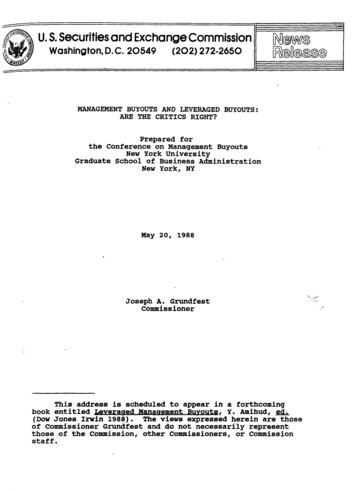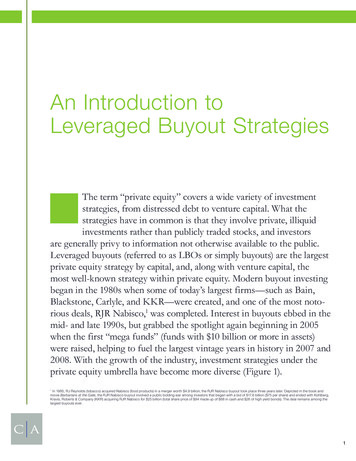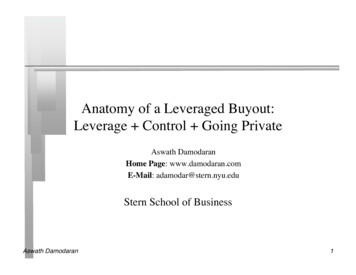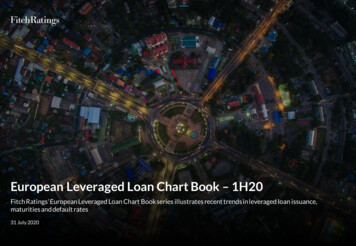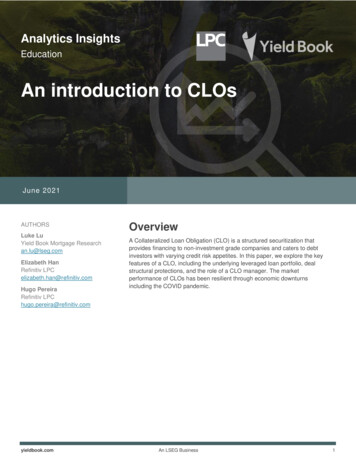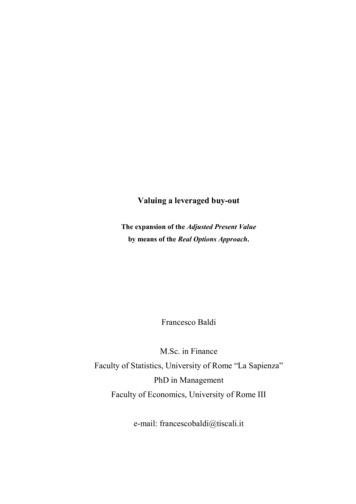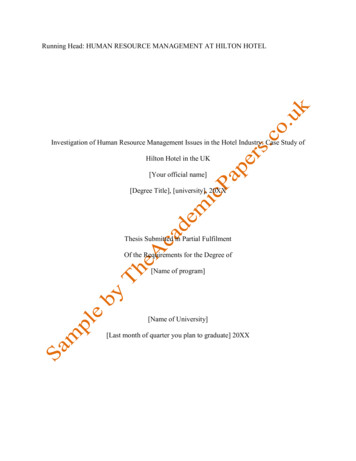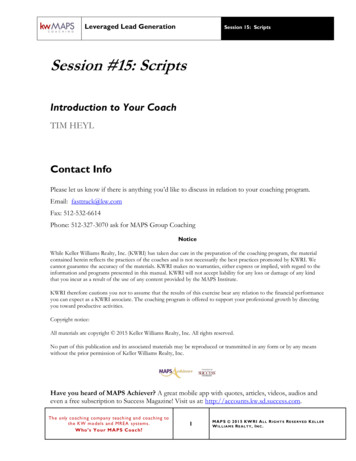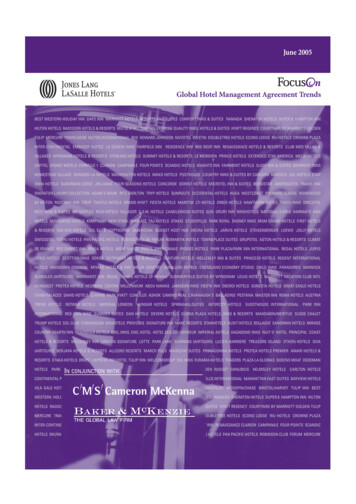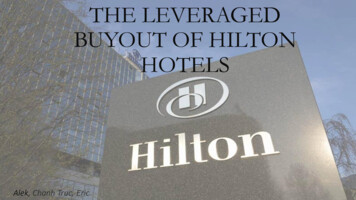
Transcription
THE LEVERAGEDBUYOUT OF HILTONHOTELSAlek, Chanh Truc, Eric
Table of planationRevPARRevenue per available roomReRequired rate of returnCCAComparable companyanalysisRdCost of debt, or yield tomaturity on existing debtFAFinancial analysisWACCDCFDiscounted cash flowThe Weighted Average Costof CapitalIEVImplied equity valueEVEnterprise valueP/EPrice to earningsEBITDAEarnings Before Interest,Taxes, Depreciation, andAmortizationEV MultipleEV / EBITDAComp. analysisComparable AnalysisEPSEarnings per shareROAReturn on assetsFCFFree cash flow
Table of contents1. Mergers and acquisitions- M&A- Takeover defenses2. Valuation- EV- WACC- Debt and leverage- Static Tradeoff Theory and Capital Irrelevance Theory- Financial distresses and their effects on the capital structure- Effect of the Pecking Order theory3. Comparable analysis- The peer universe- CCA and FA- EV multiple- P/E ratio- Price to free cash flow- True value of Hilton- How did the deal turn out in reality?
I. Mergers and Acquisitions (M&A)
Reasons for mergers and acquisitionsMerger - an occasion whentwo or more companies ororganizations join together tomake one larger companyValue increaseDiversificationAcquisition - one companypurchases most or all ofanother company's shares togain control of that companyGrowthIncrease infinancial capacityM&AAcquisitionof assetsTaxbenefitsElimination ofcompetitionQ1
Why did Blackstone acquire Hilton?REASONSBlackstone’s expertise in the sphere wouldincrease future Hilton earningsHilton was in a need of funding toimplement its aggressive expansion strategyGrowing privatization trend in the USHilton’s assets could be used as a collateralSource: ne-acquisition-was-important-for-hilton/?utm source yahoo&utm medium feed&utm content graph-1&utm campaign ilton#110011Q1
Takeover Defenses – Shark RepellencyOriginate in the Board Charter The posion pill Clauses in the Board Charter resulting in higheroperating costs once the takeover has been made Clauses in the Board Charter enabling currentshareholders to buy more shares for less during atakeover attemptQ2
Do Mergers come in waves? Short answer Yes Why? Periods with low debt financing cost lead to more options for leveragesbuyouts During stock market booms Managers can use their overpriced (P/E ratio)stock to acquire new firms Greed (Historically) Differences in valuation in certain industries leading to one industry becominga takeover targetQ3
Effect of M&A on a company's stock priceThe desired effect But what actually happenedThe announcement of an acquisition of a company usually rockets the acquiredcompany’s stock priceThe succeeding financial crisis severely decreased the global RevPAR,thus reducing the stock price of all companies in the hospitality sectorBlackstone paid a 40% acquisition premium, thus Hilton stock price wouldincreaseIn 2009, Blackstone wrote down the value of its equitystake in Hilton by 70%Q4
II. Valuation
What is Hilton Hotel’s EV?What is Hilton Hotel’s Enterprise Value? EV Equity Value (Market Cap * Shares Outstanding) Debt – Cash 2420000000 6666000000-3685618 9 082 314 382 Q5
What is Hilton Hotel’s WACCThe Weighted Average Cost of Capital of Hilton Hotel’s (WACC) WACC Thus follows: 2420000000/9086000000*0,06 6666000000/9086000000*0,04 4,5%Q6
Debt and WACCHow would twice the amount of debt impact the WACC The WACC would be 4,3% (2420/15752*0,06 13332/15752*0,04 4,3%) In general more debt makes a company more likely to default It also increases the cost of Equity as well as the risk profile of the firm andtherby the WACC of the FirmQ7
Static tradeoff theory and capital irrelevance theoryWhat is the relevance of the static tradeoff theory and capital irrelevance theory toour previous findings? Capital Irrelevance theory suggests under restrictions, the value of a firm isunaffected by its capital structure (no agency costs, investment decisionunaffected by financing decisions, riskless borrowing and lending, investors havesame expectations on company’s prospects, and capital markets are perfectlycompetitive) This goes against the theory of WACC leading to higher costsQ8
Static tradeoff theory and capital irrelevance theoryWhat is the relevance of the static tradeoff theory and capital irrelevance theory toour previous findings? Static tradeoff theory: Under the static tradeoff theory, there exists an optimalcapital structure that is a combination of debt and equity. The theory removesthe assumption that there are no costs to financial distress when the companyborrows more money, so taking on more debt does not necessarily lower WACC.This is in line with the findings in the previous question.Q8
What impact does leverage have?What if Hilton Hotel’s had no leverage? How would this impact the Equity Value? Using the formula we get an Equity Value of Hilton Hotel’s: 2 420 000 000 (Withleverage) Formula:Without leverage: 8 976 000 110 Hence, we have a risk premium of: 371%Q9
What if Hilton eliminates its debt?What will happen if Hilton elimanites its debt by issuing more shares and therbypaying of all debt? By gaining more Equity and therby eliminating debt the EV off Hilton decreases,we see this by looking at the EV formulaEV Market Cap Debt – Cash and Cash EquivalentsQ10
What if Hilton eliminates its debt?What will happen if Hilton elimanites its debt by issuing more shares and therbypaying of all debt? By gaining more Equity and therby eliminating debt the WACC of Hilton decreases,we see this again by looking at the formulaQ10
What if Hilton eliminates its debt?What will happen if Hilton elimanites its debt by issuing more shares and therbypaying of all debt? We can also ask ourselves what happens if the Re of Hilton decreases byconsidering how the stock market will react to it The price of shares will decline once more shares are issued, hence therecquired rate of return will also decline given that the dividend per share willdecline as well as the price of the share So we can conclude that Hilton Hotel’s Financial Advisor would be wrong insaying that the EV of Hilton would increase in the short-term as the firm will haveless debt and thus lowering its EVQ10
What affects a firm's cost of financial distress? Profitability (negative relationship)Liquidity (negative relationship)Size (negative relationship)Growth (negative relationship)Solvency (negative relationship)Risks (negative relationship)Q11
Effect of financial distress costsDo financial distress costs affect the capital structure of a company?YES! Companies in financial distress need to reduce investments, dividends in the short run. (These cuts however will generate losses in thelong run). Another possible solution is to refinance debt to reduce interest payments. Profit/losses increase with leverage Higher leverageincreases risks of financial distress. On the other hand, there is also a positive and significant association between corporate tax rate beforefinancing (CTRBF) and book leverage*.With the presence of a personal tax, in addition to the corporate tax, the answer to the question does not change – financial distress costs willstill weigh on the firm’s choice of capital structure. However, the presence of a personal tax will slightly decrease the effect of these costs. Why?If the company has heavy distress costs which cause it to reduce the wage rate of its employees, the income tax will also become reduced. Thus,the effect of financial distress costs is a bit smaller when there is a personal tax, compared to when there is an absence of personal tax.*Source: /33424011/FULL TEXT.PDFQ12
Effect of the Pecking Order theoryHow does the pecking order of the company allign with the decision of Blackrockto go with a leveraged buy-out?The pecking order theory states that managers display the following preference ofsources to fund investment opportunities: first, through the company’s retainedearnings, followed by debt, and choosing equity financing as a last resort. An LBOdoes not use retained earnings, instead they move on to use debt and equityfinancing which violates the pecking order theory.Q13
III.Comparables analysis
The peer universe Industry classification Size Profitability Growth rateRequirements to be includedin the peer universe Geography Capital structureQ14
Competitors in the industryEV in Billions10987Hilton Hotel’s has one of the highestEV in the industry6543210Caesar's EntertainmentFairmont Hotels &Resorts plcWyndham InternationalCenter Parcs Ltd.Extended Stay AmericaHilton HotelsQ15
Competitors in the industryUnlike its competitors, Hilton Hotelshas a low enterprise value incomparison to its EBITDAQ15
CCA vs FA (1/2)CCAFACalculating a company’s “Implied value”, based on other, similar companiesExamination of the financial information of a companyMost common components that are needed before doing a CCA – industry, geography,financial size and sample size (how many companies are being compared)Information for an FA is acquired through a company’s Income Statement, Balance Sheetor Cash Flow StatementUnlike DCF, which is mostly a personal view of company, a CCA is based on the market’sview on the sectorCommon metrics and multiples used during CCA(usually 1 sales-basedand 2 profitability-based metrics):- Revenue, EV/Revenue, Revenue Growth;- EBITDA, EV/EBITDA, EBITDA Growth;- Net Income, P/E, Net Income GrowthTime periods: Mixes of historical and projected dataSummary of Hilton’s Financial Statement for year 2006Short term debt 110.000.000Long-term debt 6.556.000.000Cash & Cash Equivalents 3.685.618EBITDA 1.179,000.000EquityShares outstanding 121.000.000Current share price 20Cost of CapitalCost of debt4%Cost of equity6%Final goal of CCA: Usually to estimate a company’s IEV or EVQ16
CCA vs FA (2/2)CCAFAPros:-Determine a benchmark value for multiples used in valuation-Provide a useful way to assess market assumptions of fundamental characteristicsbacked into valuationsPros:-Provides a detailed overall view of the performance of a company, whichallows to measure how efficient the company is at using its assets (ROA) ordetermine a business’s value via metrics such as EPSCons:Cons:- Tricky to decide whether two companies indeed belong to the same peer group,due to possible insider(management) differences, which would affect the growth inthe long run- Need to keep an eye on whether the companies’ fiscal year end on the samedate, otherwise the CCA will be imprecise- Less reliable when comparable companies are thinly traded-The FA alone does not allow for a comparison of how the company isperforming during a recession/economic boom when weighed up withother companies in the same peer group.ConclusionCompanies in the hospitality sector (such as Hilton)suffer the most during a recession (we can see thisagain now, during the Covid-19 crisis).A CCA is needed to determine how Hilton, underBlackstone’s leadership, managed to perform duringthe Great Recession, when compared to rivals fromthe same peer group.An FA, in turn, reveals the differences in Hilton’smarket strategies before and after the acquisitionand what effect did Blackstone have on thecompany.Q16
Equity and operating multiplesEquity multiplesInvestment decisions make use of equity multiples especially when an investor aspires for minority positions in companies:- P/E Ratio – the most commonly used equity multiple; needed data is easily accessible; computed as the proportion of Share Price to Earnings Per Share (EPS);- Price/Free cash flow – a basic indicator of a company’s ability to generate additional revenues, which is a crucial element in stock pricing;- Dividend Yield – used for comparisons between cash returns and investment types; computed as the proportion of Dividend Per Share to Share Pri ce;- Price/Sales – used for firms that make losses; used for quick estimates; computed as the proportion of Share Price to Sales (Revenue) Per Share.vsOperating multiplesMultiples of the functions of a business directly related to providing its goods and/or services to the market:- EV/Sales – gives investors a quantifiable metric of how to value a company based on its sales, while taking account of both the company's equity and debt. It is perceived to be moreaccurate than P/S(Price to sales), in part, because the market capitalization alone does not take a company's debt into account when valuing the company, while enterprise value doesakelosses; used for quick estimates; computed as the proportion of Share Price to Sales (Revenue) Per Share;- EV/EBITDA – used to determine the value of a company. It looks at a company the way a potential acquirer would by considering the company's debt. A low EV/EBITDA ratio signals astrong candidate for an acquisition.Equity multiples are more important for invest decisions BUT operating multiples give a better overall insight to thecompany and are thus more important when making large-scale decisions such as acquisitions and mergersQ17
Hilton Hotel‘s EV Multiple for 2006 Formula: EV/EBITDA EV: 9 082 314 382 EBITDA: 1 179 000 000 EV Multiple: 7,7Q18
Hilton's P/E ratio (for year 2006)Net profits 572m *Shares outstanding 121m EPS 572/121 4,727Current share price 20 P/E 20/4,727 4,231*Source: http://media.corporate-ir.net/media files/irol/88/88577/hilton ar 2006.pdfQ19
Evaluation of the acquisitionsComparable acquired companies (dollars in thousands)AcquirerAcquiredcompanyHarrah's Entert Caesar's EntertaiainmentnmentCost of theacquisitionEV of thecompanyNet earnings ofthe companyCost of acquisitionto EV ratioConclusions 10.400.000 7.796.496 175.3471,33Balanced costColony CapitalLLCFairmont Hotels & 3.900.000Resorts plc 4.304.850 131.1020,91Low costBlackstoneGroupWyndhamInternational 3.240.000 2.620.188- 550.7851,24High cost (Too large net losses)BrookfieldPropertyPartnersCenter Parcs Ltd. 3.720.000 1.783.952- 9.9852,09High cost (Too high acquisition costto EV ratio)BlackstoneGroupExtended StayAmerica 2.615.470 40.3561,19Balanced/low cost 3.100.000?How to deal with an unprofitable company – management change, marketing and advertisements, analysis of the competitors.In the case of Wyndham International, since the losses were so great, it is obvious that there needs to be made a drastic change in the company’scomposition – so a debt-financed investment would be a possible way of implementing these changes to the company. A merge with a competitor fromthe same peer group is also an option.Q19
Price to free cash flowCalculating Price to free cash flow for Hilton HotelsCorporation for 2006FCF Cash from operations-capital expendituresCash from operations 688 m **Capital expenditures 613m ** FCF 688-613 75mMarket capitalization 13 500m * Price to free cash flow Market capitalization/FCF 13 500/75 180Comparable acquired companies (dollars in thousands)AcquirerAcquiredcompanyHarrah's Entert Caesar's EntertaiainmentnmentMarketCapitalizationTotal Free CashFlowPrice to FreeCash Flow 7.355.185 16.248452,7Colony CapitalLLCFairmont Hotels & 2.399.114Resorts plc 180.10013,3BlackstoneGroupWyndhamInternational-- 38.299-Center Parcs Ltd.- 39.500-Since P/E 4,231BrookfieldPropertyPartners Price to cash flow is 42,5 times greater than P/EBlackstoneGroupExtended StayAmerica 1.326.313 9.442140,5*Source: http://media.corporate-ir.net/media files/irol/88/88577/hilton ar hPFNkqA.pdfQ20
Free cash flow and Net EarningsFree cash flow may be different from net income, as free cash flow takes into account the purchase of capital goods andchanges in working capital. Thus, a company with high net earnings, but low free cash flow means that the company isinvesting in capital, which is a good sign for its long-term growth.Net earnings are a good indicator of how the company is doing in the moment, but they provide little informationregarding future, long-term profitability growth.Q21
True value of HiltonDifferent ways to calculate Hilton Hotel’s true value First approach by using MultiplesIndustryAnalysis Second approach by using the EV in comparison to the industrygrowth ratioStandaloneValueQ22
True value of HiltonFirst approach by using Multiples EV Multiple: 7,7 low in comparison to other firms in the industry (see slide 14)Price to Free cash flow in comparison to PE ratioPrice to free cash flow Market capitalization/FCF 13 500/75 180Since P/E 4,231 Price to cash flow is 42,5 times greater than P/E implying a highvaluation of Hilton Hotel’s considering a normal ratio of 15-20Q22
True value of HiltonSecond Approach using only Hilton Hotel’s value EV value of Hilton Hotel’s * the industry growth rateEV of Hilton Hotels: 9 082 314 382 Growth rate of the Industry: 11,07%EV*Growth rate: 10 087 726 584 Hence, the true value of Hilton Hotels is 10 087 726 584 This valuation considers the future value of Hilton HotelsQ22
Impacts of Market Segment What were the impacts of the general market segment on our comp.analysis? High Valuations of companies in the industry due to booming market leadingto boosted EV multiples; Privatization trend in the industry leading to a lack of objective analysis andgeneral boosted estimations.Q23
How did the deal turn out in reality?The IPO was asuccess Blackrock acquired Hilton for an EVat 26 Billion and later IPO’ed it at32 billion in 2013, resulting in a 6billion profit at IPO Blackrock used 5,7 billion of itsown funds to acquire the company,and the remaining price of theacquisition was related to debtSource: -increase-in-value/Bonus Question
THE LEVERAGED BUYOUT OF HILTON HOTELS Alek, Chanh Truc, Eric. Table of abbreviations Abbreviation Explanation RevPAR Revenue per available room CCA Comparable company . (CTRBF) and book leverage*. With the presence of a personal tax, in addition to the corporate tax, the answer to th
